All About Rare Cacti Information,
Pictures, Description
Sclerocactus polyancistrus
Sclerocactus polyancistrus Engelm. & J.M.Bigelow) Britton & Rose
History of discovery
This plant was found by J.M. Bigelow (surgeon and botanist) when he was a member of expedition that 1852-1854 built the railway from the East Arkansas to Los Angeles. Later Engelmann processed describe Collected plants as Echinocactus. Later Britton and Rose include this cactus in a new Genus Sclerocactus
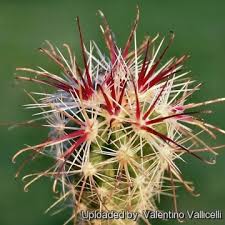
Stem: Single or in clusters, cylindric or +/- elongate, 10-40 × 5-9 cm; ribs 13-17.
Spines: Dense, obscuring stems; radial spines 10-18 per areole, white, straight, flat, 20-50 mm, central spines 9-12 per areole, 5-8 hooked, red or reddish brown (infrequently yellow), some hooked, 30-100 mm; adaxial central spines usually 3 per areole, white, usually curved or twisted, flat, usually 35-130.
Flower: With spicy, pungent odour, funnelform, 5-10 cm; outer greenish purple midstripes and rose-purple or magenta margins, rose-purple to magenta (infrequently white), blooming in Apr-Jun.
Fruit: green, tan, or red, barrel-shaped, 2.2-5 cm, dry at maturity; Notes: S. polyancistrus is the only component of the genus that lacks papillae on the style, and its style possesses grooves, somewhat reminiscent of Ferocactus.
Pubblished in: Cact. 3: 213. 1922.
Common Names include:
- Mojave eagle-claw cactus,
- Hermit cactus, Pineapple cactus,
- Red-spined fishhook cactus
- Many-Spined Devil Claw Distribution: The range of occurrence of S. polyancistrus goes from South-western Nevada to south-eastern California.
Habitat: It grows in a very arid and dry environment, on rocky alluvial, often alkalinesoils, on basalt rock hillsides limestone hillsides and desert pavement; on south to southwest-facing slopes among Mojave creosote-bush and desert scrub; 500-2500 m. Cultivation: This is one of the most beautiful cacti but also one of the more difficult to be cultivated.
Very easily rot! Only few people have tried for long time to cultivate it, usually after a few months the plant inexorably dies.
It’s thought that’s better to watch this species in photo or in the naturalhabitat rather than to try to cultivate it.
For this reasons the plant is usually grafted on a frost hardy stock.
This plant need full sun and a very good ventilation, especially in winter.Propagation: Seeds are extremely difficult to germinate (only 2-3 percent of seeds germinate) The germination is really difficult and if some seedling finally sprout, as they start to grows they disappear one by one. Grafting is often used to speed growth rate and to create a back-up for plants in collection.
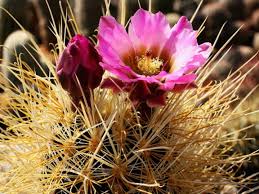
Characteristics of Cacti Plants
Introduction to Cacti
What is it about the unusual looking varieties of Cacti that have made them a much loved or much disliked member of the Plant world? I fall into the category of the former with no major justifiable reason why, I just love everything about them. My partner on the other hand really is not enamoured with them on any level.
Known as plants that thrive on neglect, they have an incredible ability to survive on little water in the driest of habitats, including one of the driest places on earth, the Atacama Desert.
Spines, Needles, Short Hairs
Much of Cacti in the absence of leaves have spines, needles or short hairs protruding out of areoles on the stem. Spines are a modified leaf botanically speaking and are even present on Cacti with leaves. The spines help prevent water loss in the plant by cutting down the air flow close to the Cactus and will provide some shade for the stem, which works towards them being a key factor in water conservation for the Cactus. When identifying Cacti, it is often the spines that are used in identification as spines within the species vary considerably in size, color, shape, hardness and numbers. Most spines are straight or have a slight curve or hook but can also be flattened in appearance. Yes, variety is the spice of life where a Cactus spine is concerned! Cactus spines
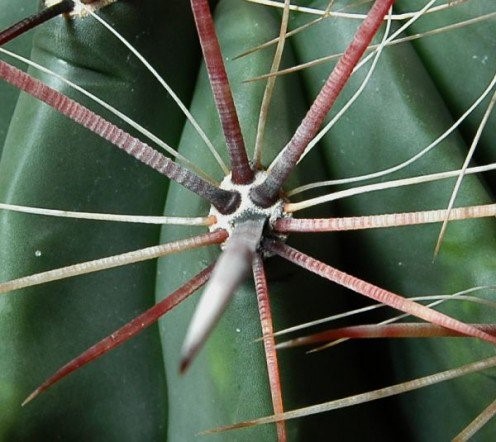
Areoles
These are unique to the Cactus Plant Family. They are visible on the stems of
Cacti and are generally identified as being the slightly raised cushion part
that is woolly or hairy and will have spines and or flowers protruding. Areoles may be oval or circular
in shape and may even appear in two separate parts. In this instance, one part
will have spines and the other will be for a flower. In most Cacti, the areoles will
only produce new spines and flowers for a few years and then will be inactive. This
means that there are generally a fixed amount of spines and flowers being
produced towards the ends of the stems as the plants grow and new areoles
appear. 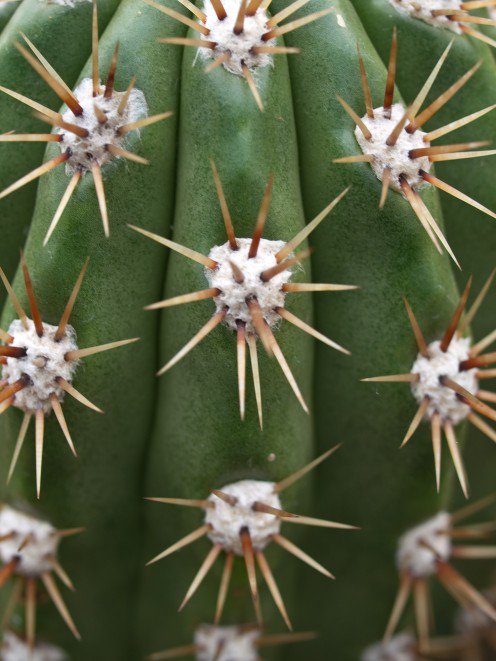
Stems
The stems of Cacti being predominantly leafless makes this
a typical characteristic feature of Cacti. Even some Cacti who appear to have
leaves have in fact flattened stems. Often waxy to the touch stems are
generally smooth in appearance or may have tubercles (little bumps) present.
They vary in shape considerably in different habitats. Short, columnar ones in
the desert all the way to ball shaped ones that cover the ground in tropical
forests. Some varieties will have a ribbed
appearance which will alter in appearance depending on how much water it is
storing at a given time. The more water, the plumper the stem and therefore the
ribs are less visible. If the stem is short of water the stem will shrink in
size and the ribs will be more obvious. In the absence of leaves
photosynthesis takes place in the stems of most Cacti and this makes them very
different to other succulent plants. 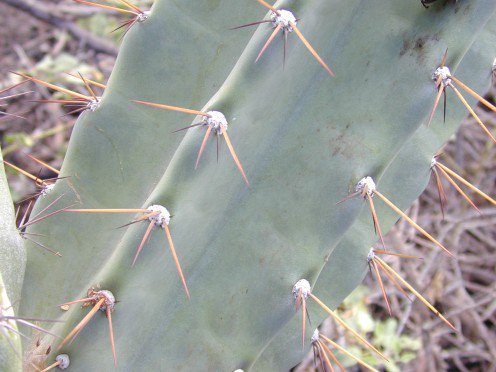
History of The Cactus
The Cactus is a plant that is predominantly native to the Americas with the exception of one variety (Rhipsalis baccifera) which is also native to Africa and Sri Lanka. When exactly the first species was introduced has been a cause of debate for many many years. The geographical distribution has led to the theory that they must have existed before the ancient continent Gondwana split into what we now know as South America and Africa. That happened during the Cretaceous period 146 to 100 million years ago. Theories on this suggest that the Rhipsalis baccifera seeds were carried in the digestive tract of migratory birds. Cacti are a very vast and varied species of succulent plant with varieties numbering between 1500 and 2000. Thanks to the introduction by humans, Cacti have become a common sight in other parts of the world, namely the Mediterranean, Australia and Hawaii., Habitats vary considerably with Cacti and may be put into 2 different groups. The Desert Cacti and The Forest Cacti. They all have similar characteristics in common that make them instantly recognisable as a Cactus, even to the untrained eye. A fact I find incredible considering there are such a wide selection of shapes, sizes and flower types within the Cacti family.
|
Comparison |
Desert Cacti |
||
|
Natural Habitat |
Semi-Desert regions of America. Contrary to the name very few will survive in sand alone. |
Forest regions of tropical America. They are grown as epiphytes on tree. |
|
|
Availability |
Nearly all Cacti fall into this category. |
Only a few are available commercially. Instantly recognized by their flattened leaf like stems and their trailing habit. |
|
|
Watering / Feeding |
Very little or no watering needed between mid Autumn and early Spring. |
May need some feeding and watering during the Winter months. |
|
|
Growing Conditions |
Requires as much sunshine as possible, particularly the flowering varieties. Very suitable for south facing gardens. |
Will require some shade during the hottest months and is suitable for north and east facing windowsills. |
|
Cacti Trivia -
- With the exception of the Pereskia and the young Opunita species, all Cacti are leafless.
- Cacti are pollinated by Hummingbirds and Insects.
- Size can be from a few centimeters to a staggering 66 ft. tall tree variety.
- The liquid inside a Cactus is a thick, viscose substance, not clear water but it can save your life and has saved many in the desert regions.
- A Cactus can have fruit, such as the Prickly Pear and can be eaten.
- Syrup can be made from Cactus fruit.
- The wood of some Cacti species is used in making roofs and walls.
- The trunk of some species is used for making an Argentinian drum called Bombo Leguero.
- The Roots of a Mexican Cactus were chewed by Aztecs for its hallucinogenic properties.
- The spines of Cacti if sterilized on hot coals may be used for sutures.